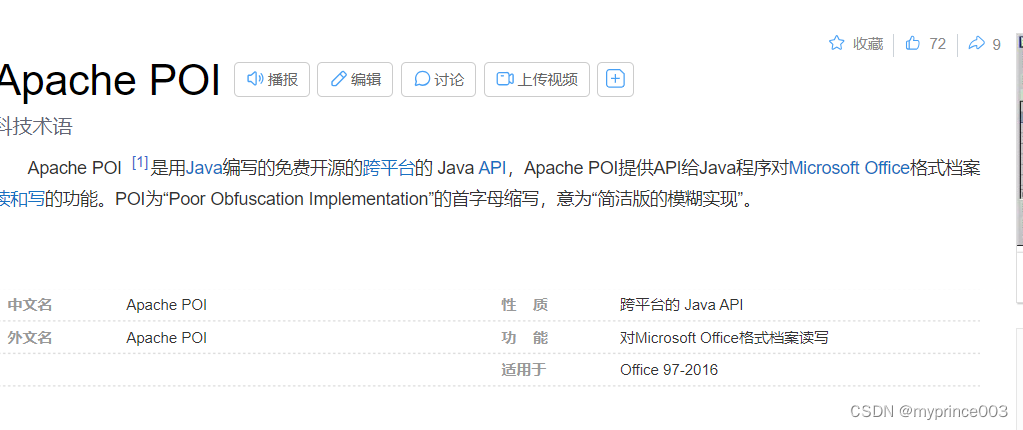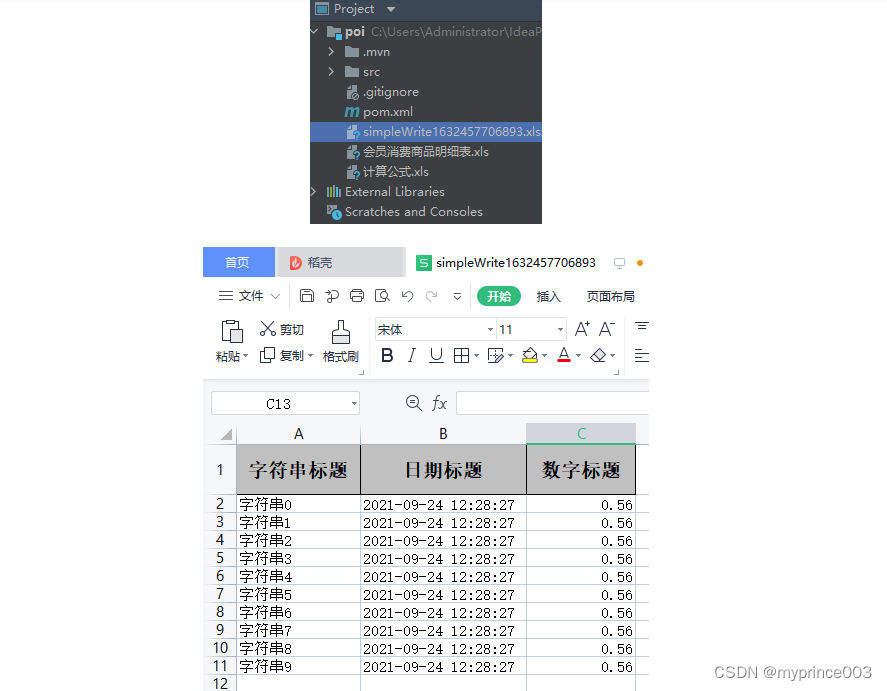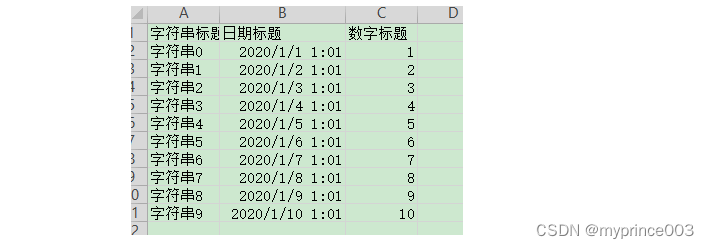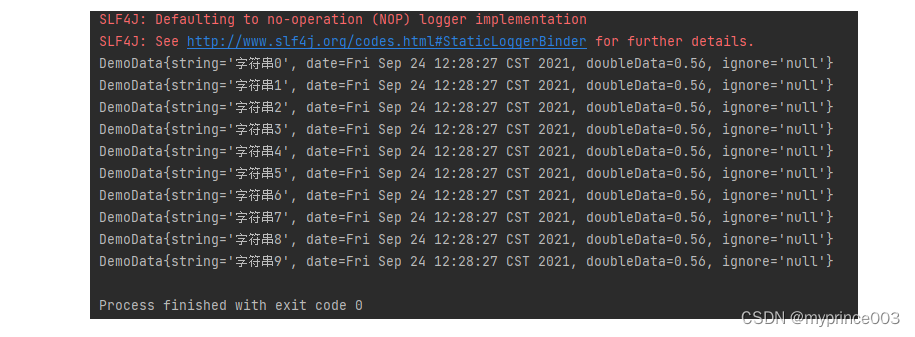详细解析POI 和 EasyExcel
在数据量需要被批量导入、导出的时候,就可以使用POI和easyExcel
常用场景:
1、将用户信息导出为excel表格(导出数据…)
2、将Excel表中的信息录入到网站数据库(习题上传…)大大减轻网站录入量!开发中经常会设计到excel的处理,如导出Excel,导入Excel到数据库中!
操作Excel目前比较流行的就是 Apache POI和阿里巴巴的easyExcel !
Apache POI
官网:https://poi.apache.org/

EasyExcel
easyExcel官网:GitHub - alibaba/easyexcel: 快速、简单避免OOM的java处理Excel工具
官方文档地址:https://www.yuque.com/easyexcel/doc/easyexcel
github地址:https://github.com/alibaba/easyexcel
EasyExcel是阿里巴巴开源的一个excel处理框架,以使用简单、节省内存著称。
EasyExcel能大大减少占用内存的主要原因是在解析Excel时没有将文件数据一次性全部加载到内存中,而是从磁盘上一行行读取数据,逐个解析。
内存问题:POl = 100w先加载到内存OOM。。再写入文件es= 1

POI-Excel操作:
1.导入依赖
<!-- xls 03 -->
<dependency>
<groupId>org.apache.poi</groupId>
<artifactId>poi</artifactId>
<version>3.9</version>
</dependency>
<!-- xlsx 07 -->
<dependency>
<groupId>org.apache.poi</groupId>
<artifactId>poi-ooxml</artifactId>
<version>3.9</version>
</dependency>
<!-- 日期格式化工具 -->
<dependency>
<groupId>joda-time</groupId>
<artifactId>joda-time</artifactId>
<version>2.10.10</version>
</dependency>
<dependency>
<groupId>junit</groupId>
<artifactId>junit</artifactId>
<scope>test</scope>
</dependency>
- 对于03版依赖和07版依赖的区别:
03版最多只能到65530行,而07版没有限制,.xls格式文件对应03版,.xlsx格式文件对应07版;
3.Excel中的对象
2.1 工作簿 2.2 工作表 2.3 行 2.4 单元格
这些对象,就是我们在Java中需要操作的对象,把这个好好理解下,有助于后面的学习。

4.写操作
4.1 工作簿(WorkBook)的继承和实现关系:

HSSFWorkbook:03版工作簿
XSSFWorkbook:07版工作簿
SXSSFWorkbook:07版工作簿增强版
4.2 基础操作:
package com.ggz.poi;
import org.apache.poi.hssf.usermodel.HSSFWorkbook;
import org.apache.poi.ss.usermodel.Cell;
import org.apache.poi.ss.usermodel.Row;
import org.apache.poi.ss.usermodel.Sheet;
import org.apache.poi.ss.usermodel.Workbook;
import org.apache.poi.xssf.streaming.SXSSFWorkbook;
import org.apache.poi.xssf.usermodel.XSSFWorkbook;
import org.joda.time.DateTime;
import org.junit.Test;
import java.io.FileOutputStream;
import java.io.IOException;
public class ExcelWriteTest {
String path = "C:\\Users\\Administrator\\IdeaProjects\\code2\\pioeasyexcel\\poi";
@Test
public void testExcelWrite03Version() throws IOException {
// 1.创建一个工作簿
Workbook workbook = new HSSFWorkbook();
// 2.创建工作表
Sheet sheet1 = workbook.createSheet("表名1"); // 表名默认是sheet0
// 3.创建第一行
Row row1 = sheet1.createRow(0);
// 4.创建单元格(1,1)
Cell cell11 = row1.createCell(0);
cell11.setCellValue("第一次使用poi");
// (1,2)
Cell cell12 = row1.createCell(1);
cell12.setCellValue("好激动啊");
// 创建第二行
Row row2 = sheet1.createRow(1);
// (2,1)
Cell cell21 = row2.createCell(0);
cell21.setCellValue("现在时间是:");
// (2,2)
Cell cell22 = row2.createCell(1);
cell22.setCellValue(new DateTime().toString("yyyy年MM月dd日 HH:mm:ss"));
// 生成文件
FileOutputStream fileOutputStream = new FileOutputStream(path + "\\poi03hss.xls");
workbook.write(fileOutputStream);
fileOutputStream.close();
System.out.println("生成完毕");
}
@Test
public void testExcelWrite07VersionXss() throws IOException {
// 1.创建一个工作簿
Workbook workbook = new XSSFWorkbook();
// 2.创建工作表
Sheet sheet1 = workbook.createSheet("表名2"); // 表名默认是sheet0
// 3.创建第一行
Row row1 = sheet1.createRow(0);
// 4.创建单元格(1,1)
Cell cell11 = row1.createCell(0);
cell11.setCellValue("第一次使用poi");
// (1,2)
Cell cell12 = row1.createCell(1);
cell12.setCellValue("好激动啊");
// 创建第二行
Row row2 = sheet1.createRow(1);
// (2,1)
Cell cell21 = row2.createCell(0);
cell21.setCellValue("现在时间是:");
// (2,2)
Cell cell22 = row2.createCell(1);
cell22.setCellValue(new DateTime().toString("yyyy年MM月dd日 HH:mm:ss"));
// 生成文件
FileOutputStream fileOutputStream = new FileOutputStream(path + "\\poi07xss.xlsx");
workbook.write(fileOutputStream);
fileOutputStream.close();
System.out.println("生成完毕");
}
@Test
public void testExcelWrite07VersionSxss() throws IOException {
// 1.创建一个工作簿
Workbook workbook = new SXSSFWorkbook();
// 2.创建工作表
Sheet sheet1 = workbook.createSheet("表名2"); // 表名默认是sheet0
// 3.创建第一行
Row row1 = sheet1.createRow(0);
// 4.创建单元格(1,1)
Cell cell11 = row1.createCell(0);
cell11.setCellValue("第一次使用poi");
// (1,2)
Cell cell12 = row1.createCell(1);
cell12.setCellValue("好激动啊");
// 创建第二行
Row row2 = sheet1.createRow(1);
// (2,1)
Cell cell21 = row2.createCell(0);
cell21.setCellValue("现在时间是:");
// (2,2)
Cell cell22 = row2.createCell(1);
cell22.setCellValue(new DateTime().toString("yyyy年MM月dd日 HH:mm:ss"));
// 生成文件
FileOutputStream fileOutputStream = new FileOutputStream(path + "\\poi07sxss.xlsx");
workbook.write(fileOutputStream);
fileOutputStream.close();
System.out.println("生成完毕");
}
}
4.3 BigData
4.3.1 HSSFWorkbook:03版工作簿 (大文件写)
缺点 ∶ 最多只能处理65536行,否则会抛出异常
优点 : 过程中写入缓存,不操作磁盘,最后一次性写入磁盘,速度快

@Test
public void testBigDataWrite03VersionHss() throws IOException {
long start = System.currentTimeMillis();
// 1.创建一个工作簿
Workbook workbook = new HSSFWorkbook();
// 2.创建工作表
Sheet sheet1 = workbook.createSheet("表名2"); // 表名默认是sheet0
// 循环创建行
for (int rowNum = 0; rowNum < 65536; rowNum++) {
Row row = sheet1.createRow(rowNum);
// 循环创建单元格
for (int cellNum = 0; cellNum < 10; cellNum++) {
Cell cell = row.createCell(cellNum);
cell.setCellValue(new DateTime().toString("HH:mm:ss"));
}
}
System.out.println("HSS创建完毕!");
// 生成文件
FileOutputStream fileOutputStream = new FileOutputStream(path + "\\BigDataPoi03.xls");
workbook.write(fileOutputStream);
fileOutputStream.close();
System.out.println("SSH生成完毕");
long end = System.currentTimeMillis();
System.out.println((double) (end - start) / 1000);
}
运行结果:

4.3.2 XSSFWorkbook:07版工作簿
@Test
public void testBigDataWrite07VersionXss() throws IOException {
long start = System.currentTimeMillis();
// 1.创建一个工作簿
Workbook workbook = new XSSFWorkbook();
// 2.创建工作表
Sheet sheet1 = workbook.createSheet("表名2"); // 表名默认是sheet0
// 循环创建行
for (int rowNum = 0; rowNum < 65536; rowNum++) {
Row row = sheet1.createRow(rowNum);
// 循环创建单元格
for (int cellNum = 0; cellNum < 10; cellNum++) {
Cell cell = row.createCell(cellNum);
cell.setCellValue(new DateTime().toString("HH:mm:ss"));
}
}
System.out.println("XSS创建完毕!");
// 生成文件
FileOutputStream fileOutputStream = new FileOutputStream(path + "\\BigDataPoi07Xss.xls");
workbook.write(fileOutputStream);
fileOutputStream.close();
System.out.println("XSS生成完毕");
long end = System.currentTimeMillis();
System.out.println((double) (end - start) / 1000);
}
运行结果:

4.3.2 SXSSFWorkbook:07版工作簿增强版
@Test
public void testBigDataWrite07VersionSxss() throws IOException {
long start = System.currentTimeMillis();
// 1.创建一个工作簿
Workbook workbook = new SXSSFWorkbook();
// 2.创建工作表
Sheet sheet1 = workbook.createSheet("表名2"); // 表名默认是sheet0
// 循环创建行
for (int rowNum = 0; rowNum < 65536; rowNum++) {
Row row = sheet1.createRow(rowNum);
// 循环创建单元格
for (int cellNum = 0; cellNum < 10; cellNum++) {
Cell cell = row.createCell(cellNum);
cell.setCellValue(new DateTime().toString("HH:mm:ss"));
}
}
System.out.println("SXSS创建完毕!");
// 生成文件
FileOutputStream fileOutputStream = new FileOutputStream(path + "\\BigDataPoi07SXss.xls");
workbook.write(fileOutputStream);
fileOutputStream.close();
// 清除临时文件
((SXSSFWorkbook)workbook).dispose();
System.out.println("SXSS生成完毕");
long end = System.currentTimeMillis();
System.out.println((double) (end - start) / 1000);
}
执行结果:

5. POI-Excel读操作:
5.1基础操作:
package com.ggz.poi;
import org.apache.poi.hssf.usermodel.HSSFCell;
import org.apache.poi.hssf.usermodel.HSSFRow;
import org.apache.poi.hssf.usermodel.HSSFSheet;
import org.apache.poi.hssf.usermodel.HSSFWorkbook;
import org.apache.poi.xssf.usermodel.XSSFCell;
import org.apache.poi.xssf.usermodel.XSSFRow;
import org.apache.poi.xssf.usermodel.XSSFSheet;
import org.apache.poi.xssf.usermodel.XSSFWorkbook;
import org.junit.Test;
import java.io.FileInputStream;
import java.io.IOException;
public class ExcelReadTest {
String path = "C:\\Users\\Administrator\\IdeaProjects\\code2\\pioeasyexcel\\poi";
@Test
public void testReadHss() throws IOException {
// 获取文件流
FileInputStream fileInputStream = new FileInputStream(path + "\\会员消费商品明细表.xls");
// 创建一个工作簿, Excel里面的操作,这边都有
HSSFWorkbook workbook = new HSSFWorkbook(fileInputStream);
// 创建工作表
HSSFSheet sheet = workbook.getSheetAt(0);
// 获取一行
HSSFRow row = sheet.getRow(0);
// 获取一个单元格(1,1)
HSSFCell cell = row.getCell(0);
System.out.println(cell.getStringCellValue());
fileInputStream.close();
}
@Test
public void testReadXss() throws IOException {
// 获取文件流
FileInputStream fileInputStream = new FileInputStream(path + "\\BigDataPoi07SXss.xls");
// 创建一个工作簿, Excel里面的操作,这边都有
XSSFWorkbook workbook = new XSSFWorkbook(fileInputStream);
// 创建工作表
XSSFSheet sheet = workbook.getSheetAt(0);
// 获取一行
XSSFRow row = sheet.getRow(0);
// 获取一个单元格(1,1)
XSSFCell cell = row.getCell(0);
System.out.println(cell.getStringCellValue());
fileInputStream.close();
}
}
5.2 复杂数据类型读取:
主要是注意数据类型转换问题!看起来很复杂,其实就是双重循环和判断,不过这对我来说没什么。
package com.ggz.poi;
import org.apache.poi.hssf.usermodel.HSSFCell;
import org.apache.poi.hssf.usermodel.HSSFDateUtil;
import org.apache.poi.hssf.usermodel.HSSFWorkbook;
import org.apache.poi.ss.usermodel.Cell;
import org.apache.poi.ss.usermodel.Row;
import org.apache.poi.ss.usermodel.Sheet;
import org.apache.poi.ss.usermodel.Workbook;
import org.joda.time.DateTime;
import org.junit.Test;
import java.io.FileInputStream;
import java.io.IOException;
import java.util.Date;
public class EasyExcel {
private final String PATH = "C:\\Users\\Administrator\\IdeaProjects\\code2\\pioeasyexcel\\poi";
@Test
public void testReadHSS() throws IOException {
// 通过流获取工作簿、工作表等对象
FileInputStream fileInputStream = new FileInputStream(PATH + "\\会员消费商品明细表.xls");
Workbook workbook = new HSSFWorkbook(fileInputStream);
Sheet sheet = workbook.getSheetAt(0);
// 获取标题内容
Row rowTitle = sheet.getRow(0);
if(rowTitle != null){
int cellTotal = rowTitle.getPhysicalNumberOfCells();
for (int cellNum = 0; cellNum < cellTotal; cellNum++) {
Cell cell = rowTitle.getCell(cellNum);
if (cell != null){
int cellType = cell.getCellType();
String stringCellValue = cell.getStringCellValue();
System.out.print(stringCellValue + " | ");
}
}
System.out.println();
}
// 获取内容
int rowTotal = sheet.getPhysicalNumberOfRows();
for (int rowNum = 1; rowNum < rowTotal; rowNum++) {
Row row = sheet.getRow(rowNum);
if(row != null){
int cellTotal = row.getPhysicalNumberOfCells();
for (int cellNum = 0; cellNum < cellTotal; cellNum++) {
Cell cell = row.getCell(cellNum);
int cellType = cell.getCellType();
// 判断内容类型
switch (cellType){
case HSSFCell.CELL_TYPE_STRING: // String类型
String stringCellValue = cell.getStringCellValue();
System.out.print(stringCellValue + " | ");
break;
case HSSFCell.CELL_TYPE_NUMERIC: // 数字类型(日期、普通数字)
if (HSSFDateUtil.isCellDateFormatted(cell)){ // 日期类型
Date dateCellValue = cell.getDateCellValue();
String time = new DateTime(dateCellValue).toString("yyyy-MM-dd");
System.out.print(time + " | ");
} else { // 普通数字
double numericCellValue = cell.getNumericCellValue();
System.out.print(numericCellValue + " | ");
}
break;
case HSSFCell.CELL_TYPE_BLANK: // 空白
System.out.print(" | ");
break;
case HSSFCell.CELL_TYPE_BOOLEAN: // 布尔值
boolean booleanCellValue = cell.getBooleanCellValue();
System.out.print(booleanCellValue + " | ");
break;
case HSSFCell.CELL_TYPE_ERROR: // 错误类型
System.out.print("数据类型错误");
break;
}
}
System.out.println();
}
}
fileInputStream.close();
}
}
5.3 计算公式
@Test
public void testFormula() throws Exception{
FileInputStream fileInputStream = new FileInputStream(PATH + "\\计算公式.xls");
Workbook workbook = new HSSFWorkbook(fileInputStream);
Sheet sheetAt = workbook.getSheetAt(0);
// 获取表中的计算公式
FormulaEvaluator evaluator = new HSSFFormulaEvaluator((HSSFWorkbook) workbook);
int physicalNumberOfRows = sheetAt.getPhysicalNumberOfRows();
for (int rowNum = 0; rowNum < physicalNumberOfRows; rowNum++) {
Row row = sheetAt.getRow(rowNum);
if (row != null){
int physicalNumberOfCells = row.getPhysicalNumberOfCells();
for (int cellNum = 0; cellNum < physicalNumberOfCells; cellNum++) {
Cell cell = row.getCell(cellNum);
if (cell != null){
int cellType = cell.getCellType();
// 判断内容类型
switch (cellType){
case HSSFCell.CELL_TYPE_FORMULA: // 公式
// 计算公式
String formula = cell.getCellFormula();
CellValue evaluate = evaluator.evaluate(cell);
String e = evaluate.formatAsString();
System.out.print(e + " | ");
break;
case HSSFCell.CELL_TYPE_STRING: // String类型
String stringCellValue = cell.getStringCellValue();
System.out.print(stringCellValue + " | ");
break;
case HSSFCell.CELL_TYPE_NUMERIC: // 数字类型(日期、普通数字)
if (HSSFDateUtil.isCellDateFormatted(cell)){ // 日期类型
Date dateCellValue = cell.getDateCellValue();
String time = new DateTime(dateCellValue).toString("yyyy-MM-dd");
System.out.print(time + " | ");
} else { // 普通数字
double numericCellValue = cell.getNumericCellValue();
System.out.print(numericCellValue + " | ");
}
break;
case HSSFCell.CELL_TYPE_BLANK: // 空白
System.out.print(" | ");
break;
case HSSFCell.CELL_TYPE_BOOLEAN: // 布尔值
boolean booleanCellValue = cell.getBooleanCellValue();
System.out.print(booleanCellValue + " | ");
break;
case HSSFCell.CELL_TYPE_ERROR: // 错误类型
System.out.print("数据类型错误");
break;
}
}
}
System.out.println();
}
}
}
EasyExcel操作:
按照我的流程,结合官方文档给出的代码去写,妥妥的没问题。
1.导入依赖:
注意:easyExcel依赖本身就依赖了 poi 和 poi-ooxml 两个包,注意避免冲突。
亲测:当我们排除 easyExcel 中的poi 和 poi-ooxml 两个包,会导致版本的冲突,找不到一些方法,这可能是依赖版本升级以后,有些方法被弃用导致的。最稳妥的做法就是将我们自己导入的 poi 那两个依赖去掉。
<!-- slf4j -->
<dependency>
<groupId>org.slf4j</groupId>
<artifactId>slf4j-simple</artifactId>
<scope>compile</scope>
</dependency>
<!--fastJson-->
<dependency>
<groupId>com.alibaba</groupId>
<artifactId>fastjson</artifactId>
<version>1.2.75</version>
</dependency>
<!-- easyExcel-->
<dependency>
<groupId>com.alibaba</groupId>
<artifactId>easyexcel</artifactId>
<version>2.2.0-beta2</version>
</dependency>
<!-- xls 03 -->
<!-- <dependency>
<groupId>org.apache.poi</groupId>
<artifactId>poi</artifactId>
<version>3.9</version>
</dependency>-->
<!-- xlsx 07 -->
<!--<dependency>
<groupId>org.apache.poi</groupId>
<artifactId>poi-ooxml</artifactId>
<version>3.9</version>
</dependency>-->
2.写入测试
demo:最简单的写

2.1 创建实体:
官方文档代码中有@Data注解,其实就是 lombok 这个依赖的注解,可以在程序启动时,自动帮我们生成 get、set 方法。有兴趣的小伙伴自行研究,字段较少,我使用的原始的方法,自己写的get、set、构造方法等,就不贴出来了。
ps:Lombok很强大,可以只使用注解就能实现在程序启动时自动生成 get、set、toString、hash、构造方法等,用于简化代码,允许链式编程等等,不过也有弊端,就等可爱的你,自己去发现了。
package com.ggz.poi.entity;
import com.alibaba.excel.annotation.ExcelIgnore;
import com.alibaba.excel.annotation.ExcelProperty;
import java.util.Date;
// @Data
public class DemoData {
@ExcelProperty("字符串标题")
private String string;
@ExcelProperty("日期标题")
private Date date;
@ExcelProperty("数字标题")
private Double doubleData;
/**
* 忽略这个字段
*/
@ExcelIgnore
private String ignore;
2.2 生成数据:
如果是在日常开发中,数据的来源往往是来自数据库、缓存等。
private List<DemoData> data() {
List<DemoData> list = new ArrayList<DemoData>();
for (int i = 0; i < 10; i++) {
DemoData data = new DemoData();
data.setString("字符串" + i);
data.setDate(new Date());
data.setDoubleData(0.56);
list.add(data);
}
return list;
}
2.3 写入文件:
easyExcel 官方文档中给出了3种写入的操作方式,我这里选用的是最简单的。
@Test
public void testEasyExcelWrite(){
// 写法2
String fileName = PATH + "simpleWrite" + System.currentTimeMillis() + ".xlsx";
// 这里 需要指定写用哪个class去写,然后写到第一个sheet,名字为模板 然后文件流会自动关闭
// 如果这里想使用03 则 传入excelType参数即可
// fileName 文件写出的目录和工作簿名称
// DemoData.class 写出对象的字节码文件
// sheet("模板") 工作表名称
// data() 写入到工作表的数据
EasyExcel.write(fileName, DemoData.class).sheet("模板").doWrite(data());
}
2.4 生成结果:

3.读取测试
demo:最简单的读

3.1 创建实体:
可以继续使用刚刚写入时的 DemoData 实体。
3.2 配置监听:
package com.ggz.poi.listener;
import com.alibaba.excel.context.AnalysisContext;
import com.alibaba.excel.event.AnalysisEventListener;
import com.alibaba.fastjson.JSON;
import com.ggz.poi.entity.DemoData;
import org.slf4j.Logger;
import org.slf4j.LoggerFactory;
import java.util.ArrayList;
import java.util.List;
// 有个很重要的点 DemoDataListener 不能被spring管理,要每次读取excel都要new,然后里面用到spring可以构造方法传进去
public class DemoDataListener extends AnalysisEventListener<DemoData> {
private static final Logger LOGGER = LoggerFactory.getLogger(DemoDataListener.class);
/**
* 每隔5条存储数据库,实际使用中可以3000条,然后清理list ,方便内存回收
*/
private static final int BATCH_COUNT = 3000;
/**
* 缓存的数据
*/
private List<DemoData> list = new ArrayList<>(BATCH_COUNT);
/**
* 假设这个是一个DAO,当然有业务逻辑这个也可以是一个service。当然如果不用存储这个对象没用。
*/
/* private DemoDAO demoDAO;
public DemoDataListener() {
// 这里是demo,所以随便new一个。实际使用如果到了spring,请使用下面的有参构造函数
demoDAO = new DemoDAO();
}*/
/**
* 如果使用了spring,请使用这个构造方法。每次创建Listener的时候需要把spring管理的类传进来
*
* @param demoDAO
*/
/* public DemoDataListener(DemoDAO demoDAO) {
this.demoDAO = demoDAO;
}*/
/**
* 这个每一条数据解析都会来调用
*
* @param data one row value. Is is same as {@link AnalysisContext#readRowHolder()}
* @param context
*/
@Override
public void invoke(DemoData data, AnalysisContext context) {
LOGGER.info("解析到一条数据:{}", JSON.toJSONString(data));
list.add(data);
// 达到BATCH_COUNT了,需要去存储一次数据库,防止数据几万条数据在内存,容易OOM
if (list.size() >= BATCH_COUNT) {
saveData();
// 存储完成清理 list
list = new ArrayList<>(BATCH_COUNT);
}
}
/**
* 所有数据解析完成了 都会来调用
*
* @param context
*/
@Override
public void doAfterAllAnalysed(AnalysisContext context) {
// 这里也要保存数据,确保最后遗留的数据也存储到数据库
saveData();
LOGGER.info("所有数据解析完成!");
}
/**
* 加上存储数据库
*/
private void saveData() {
LOGGER.info("{}条数据,开始存储数据库!", list.size());
// demoDAO.save(list);
for (int i = 0; i < list.size(); i++) {
System.out.println(list.get(i).toString());
}
LOGGER.info("存储数据库成功!");
}
}
3.3 读取文件:
private static final Logger LOGGER = LoggerFactory.getLogger(EasyExcelTest.class);
/**
* 最简单的读
* <p>
* 1. 创建excel对应的实体对象 参照{@link DemoData}
* <p>
* 2. 由于默认一行行的读取excel,所以需要创建excel一行一行的回调监听器,参照{@link DemoDataListener}
* <p>
* 3. 直接读即可
*/
@Test
public void testSimpleRead(){
// 有个很重要的点 DemoDataListener 不能被spring管理,要每次读取excel都要new,然后里面用到spring可以构造方法传进去
// 写法3:
String fileName = PATH + "simpleWrite1632457706893.xlsx";
// 这里 需要指定读用哪个class去读,然后读取第一个sheet 文件流会自动关闭
EasyExcel.read(fileName, DemoData.class, new DemoDataListener()).sheet().doRead();
}
3.4 执行结果:
我这里 slf 日志没有打印,原因是 slf4j 依赖有问题,导个依赖就好了,前面补上了。如果是复制的我贴出来的依赖,是没有问题的。

固定套路:
1、写入,固定类格式进行写入
2、读取,根据监听器设置的规则进行读取!
本文来自互联网用户投稿,该文观点仅代表作者本人,不代表本站立场。本站仅提供信息存储空间服务,不拥有所有权,不承担相关法律责任。 如若内容造成侵权/违法违规/事实不符,请联系我的编程经验分享网邮箱:veading@qq.com进行投诉反馈,一经查实,立即删除!